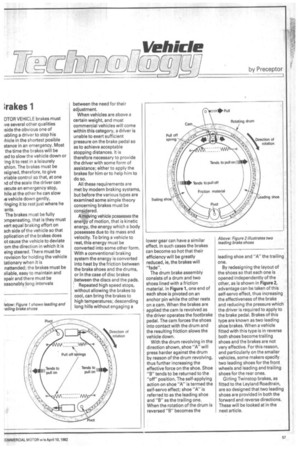Irakes 1
Page 51

If you've noticed an error in this article please click here to report it so we can fix it.
OTOR VEHICLE brakes must ive several other qualities tside the obvious one of tabling a driver to stop his :hide in the shortest posible stance in an emergency. Most the time the brakes will be ;ed to slow the vehicle down or ing it to rest in a leisurely shion. The brakes must be ?signed, therefore, to give viable control so that, at one Id of the scale the driver can (ecute an emergency stop, bile at the other he can slow le vehicle down gently, ringing it to rest just where he ants.
The brakes must be fully Dmpensating, that is they must Ken equal braking effort on ach side of the vehicle so that pplication of the brakes does ot cause the vehicle to deviate .om the direction in which it is eing steered. There must be rovision for holding the vehicle tationary when it is
nattended; the brakes must be eliable, easy to maintain and epair and there must be easonably long intervals between the need for their adjustment.
When vehicles are above a certain weight, and most commercial vehicles will come within this category, a driver is unable to exert sufficient pressure on the brake pedal so as to achieve acceptable stopping distances. It is therefore necessary to provide the driver with some form of assistance; either to apply the brakes for him or to help him to do so.
All these requirements are met by modern braking systems, but before the various types are examined some simple theory concerning brakes must be considered.
A moving vehicle possesses the energy of motion, that is kinetic energy, the energy which a body possesses due to its mass and velocity. To bring a vehicle to rest, this energy must be converted into some other form. With a conventional braking system the energy is converted into heat by the friction between the brake shoes and the drums, or in the case of disc brakes between the discs and the pads. , Repeated high speed stops, without allowing the brakes to cool, can bring the brakes to high temperatures; descending long hills without engaging a lower gear can have a similar effect. In such cases the brakes can become so hot that their efficiency will be greatly reduced, le, the brakes will "fade".
The drum brake assembly consists of a drum and two shoes lined with a friction material. In Figure 1, one end of each shoe is pivoted on an anchor pin while the other rests on a cam. When the brakes are applied the cam is revolved as the driver operates the footbrake pedal. The cam forces the shoes into contact with the drum and the resulting friction slows the vehicle down.
With the drum revolving in the direction shown, shoe "A" will press harder against the drum by reason of the drum revolving, thus further increasing the effective force on the shoe. Shoe "B" tends to be returned to the "off" position. The self-applying action on shoe "A" is termed the self-servo effect; shoe "A" is referred to as the leading shoe and "B" as the trailing one. When the rotation of the drum is reversed "B" becomes the leading shoe and "A" the trailing one.
By redesigning the layout of the shoes so that each one is opened independently of the other, as is shown in Figure 2, advantage can be taken of this self-servo effect, thus increasing the effectiveness of the brake and reducing the pressure which the driver is required to apply to the brake pedal. Brakes of this type are known as two leading shoe brakes. When a vehicle fitted with this type is in reverse both shoes become trailing shoes and the brakes are not very effective. For this reason, and particularly on the smaller vehicles, some makers specify two leading shoes for the front wheels and leading and trailing shoes for the rear ones.
Girling Twinstop brakes, as fitted to the Leyland Roadtrain, are so designed that two leading shoes are provided in both the forward and reverse directions. These will be looked at in the next article.




















































